11 Best Gaming Monitors in 2025: Only Winners
Eneba Hub contains affiliate links, which means we may earn a small commission if you make a purchase through them—at no extra cost to you. Learn more
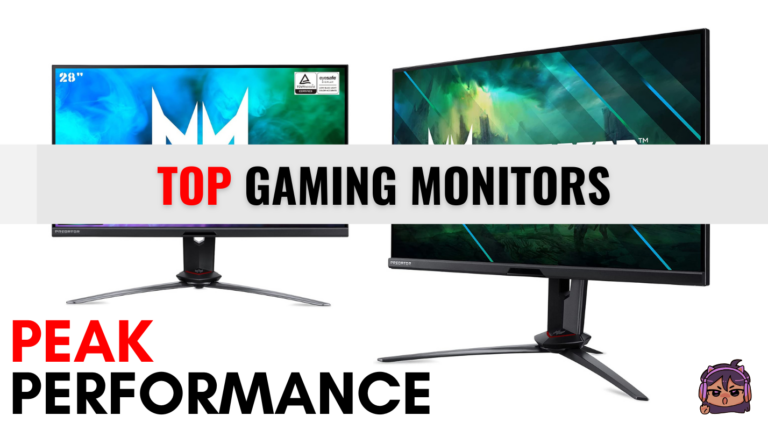
If you’re searching for the best gaming monitor, you already know that not all displays are created equal. Choosing a new gaming monitor can mean the difference between smooth performance and frustrating lag.
I’ve analyzed specs and examined real gamer feedback to curate this list of top-tier monitors for every type of player.
If you’re looking for a high-priced brilliant OLED panel or something that has a lower price but packs features and values, then stay right here. This ultimate guide to picking out the best monitor will tell you about: specs, pros/cons, and everything else you’ll need to know before buying it!
I’ve also included alternative options and key information for those who want to check out different monitors and who want their information straight up. This guide will help you pick the best monitor for gaming without second-guessing your purchase.
Jump to:
Our Top Picks for Best Gaming Monitors
Choosing the best gaming monitor depends on your needs: high refresh rates, OLED clarity, or affordability? Our top five contenders deliver across all those fields:
- ASUS ROG Swift 32” 4K Gaming Monitor – A powerhouse with 4K resolution + 144Hz refresh rate.
- Acer Predator XB283K – The best budget gaming monitor with 4K UHD resolution.
- LG 45GR65DC-B Ultragear – The best curved gaming monitor, featuring a DQHD ultrawide panel and 200Hz refresh rate.
- Sony 27” INZONE M9 – The best 4K gaming monitor, combining a 144Hz refresh rate with full-array local dimming.
- AOC Agon PRO AG346UCD 34″ – The best ultrawide monitor with 175Hz refresh rate.
Scroll down for in-depth reviews of all gaming monitors that made it to this list.
11 Best Gaming Monitors Reviews
I break down each model to help you find the perfect fit. You can expect information on:
- Specifications: Screen size, resolution, panel type, etc.
- Pros and Cons: I showcase standout pros and potential cons for each monitor.
- Thorough evaluation of monitor’s performance: I touch down on colors, visuals, performance, and more.
Let’s dive in.
1. ASUS ROG Swift 32” 4K Gaming Monitor [Best Overall]
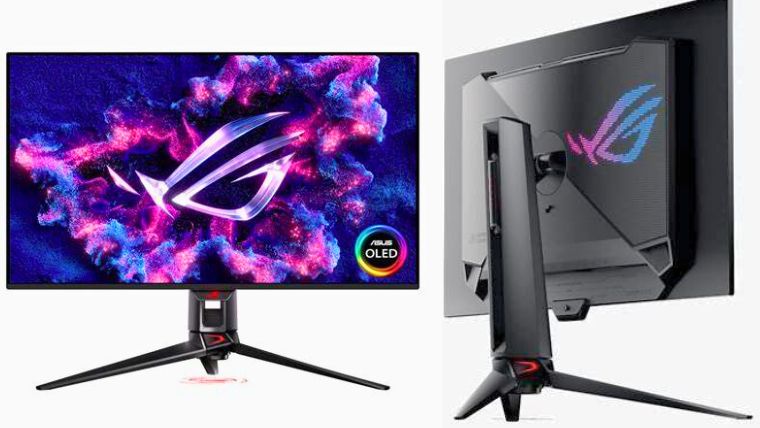
| Specifications | Details |
| Screen Size | 32 inches |
| Aspect Ratio | 16:9 |
| Panel Type | QD-OLED panel |
| Response Time | 1ms (MPRT) / ~4ms GtG |
| Resolution | 3840 x 2160 (4K UHD) |
| Refresh Rate | 144Hz (OC up to 155Hz) |
| Brightness | 450 nits SDR, 600 nits Peak (HDR600) |
| Weight | 6.1 kg (13.45 lbs) |
The ASUS ROG Swift 32” 4K stands out as the best gaming monitor you can buy right now. Its specs impress right away. It has a 32-inch IPS panel pushing a full 4K UHD image up to 144Hz means games look incredibly sharp yet fluid. In practice, the gaming monitor lives up to the promise as a great PC, PS and Xbox Series X monitor.
Colors are universally praised as rich and accurate; one user measured essentially 99% Adobe RGB and 92% DCI-P3 coverage, noting the “wide gamut makes every game world look vibrant and lifelike”. Factory calibration is on point. HDR content particularly benefits. The DisplayHDR 600 implementation and 16-zone dimming produces punchy highlights and respectable blacks.
HDR games like Cyberpunk 2077 will treat you to eye-searing neon lights against inky night skies; the HDR contrast feels “excellent” for a monitor in this class. Only in the darkest scenes do you notice the limited zones (a faint halo here or there), which is a minor trade-off. Where the ROG Swift really shines is its motion performance.
With a true 144Hz native refresh (and an optional 155Hz overclock), fast action feels buttery-smooth. Competitive FPS titles like Valorant or Apex Legends exhibit virtually no blur or ghosting. Input lag is nearly non-existent, and the panel’s 1ms MPRT response plus adaptive-sync support means no tearing or stutters either. When frame rates fluctuate, G-Sync Compatible mode keeps the experience fluid.
HDMI 2.1 support enables full 4K 120Hz gaming on PS5 and Xbox Series X, while DisplayPort 1.4 (with DSC) delivers top-tier PC performance. Console gaming benefits from VRR support, and PC gamers get extras like Shadow Boost for improved visibility in dark areas.
| Pros | Cons |
|---|---|
| ✅ Stunning 4K image | ❌ Slightly slower pixel response than some smaller 4K IPS panels |
| ✅ Excellent HDR contrast | |
| ✅ High 144Hz refresh | |
| ✅ HDMI 2.1 support for 4K 120Hz gaming on PS5/XSX | |
| ✅ Low input lag and adaptive sync |
Final Verdict: ASUS ROG Swift 32” 4K Gaming Monitor is next-gen ready and has a premium build and features. If you want an alternative option, the Acer Predator XB283K is a fantastic high-quality gaming monitor at a lower cost.
Check out ASUS ROG Swift 32” 4K on Amazon >
2. Acer Predator XB283K 28” Gaming Monitor [Best Budget Monitor]
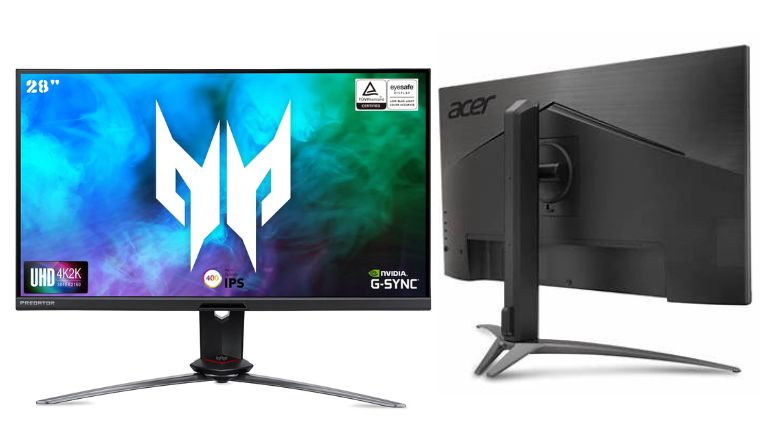
| Specifications | Details |
| Screen Size | 28 inches |
| Aspect Ratio | 16:9 |
| Panel Type | Agile-Splendor IPS Panel |
| Response Time | 1ms GtG (Fast IPS) |
| Resolution | 3840 x 2160 (4K UHD) |
| Refresh Rate | 144Hz (VRR FreeSync Premium) |
| Brightness | 400 nits PEAK (HDR400 Certified) |
| Weight | 4.8 kg (10.58 lbs) |
Finding an affordable 4k gaming monitor that doesn’t skimp on features can feel impossible, but the Acer Predator XB283K delivers true 4K 144Hz gaming performance at a budget-friendly price. For around a fair price of $400 (on sale), it gives you sharp details and vibrant colors. It has an impressive Agile-Splendor IPS panel, so you can thank the high-quality visuals for that.
You’ll immediately notice the extra clarity and the 90% DCI-P3 color gamut delivers rich eye candy. HDR support (DisplayHDR 400) adds a noticeable brightness boost. With a peak brightness of 400 nits, it combats glare well and provides decent contrast for an IPS panel. But the most important detail is where the Predator XB283K truly shines, and that would be in its gaming performance.
Fast-paced games like DOOM Eternal that demand a lot from your device feel incredibly smooth. This is all thanks to a 144Hz refresh rate, 1 ms response time, plus G-Sync/FreeSync specs. You can expect minimal blur and ghosting. Playing titles like Halo Infinite on Xbox Series X at 4K 120Hz should also be a seamless experience. You can thank HDMI 2.1 support for that.
All in all, this monitor is an excellent choice for competitive gaming. It offers low input lag and great motion handling. It doesn’t feel cheaply made at all, even if it’s a budget model. The stand is sturdy and well-adjusted. A USB-C port with 65W power delivery and a KVM switch makes switching between a gaming PC and a laptop effortless. Plus, additional USB-A ports come as nice bonuses. Built-in speakers are basic but usable for casual tasks.
| Pros | Cons |
|---|---|
| ✅Great value for 4K 144Hz | ❌ DisplayHDR 400 yields only modest HDR impact |
| ✅ Sharp and colorful IPS panel | |
| ✅ HDMI 2.1 ports enable 4K 120Hz gaming on PS5/XSX | |
| ✅ Smooth, low-blur motion | |
| ✅ Built-in KVM switch and USB hub simplify multi-device setups |
Final Verdict: Acer Predator XB283K 28” is an affordable 4K 144Hz gaming monitor with HDMI 2.1 for next-gen consoles. If you want a similar option, go for the ASUS TUF 27”. This is by far the best budget gaming monitor that offers great value with 1440p resolution and high refresh rates.
Get Acer Predator XB283K 28 on Amazon >
3. LG 45GR65DC-B UltraGear 45” Gaming Monitor [Best Curved Monitor]
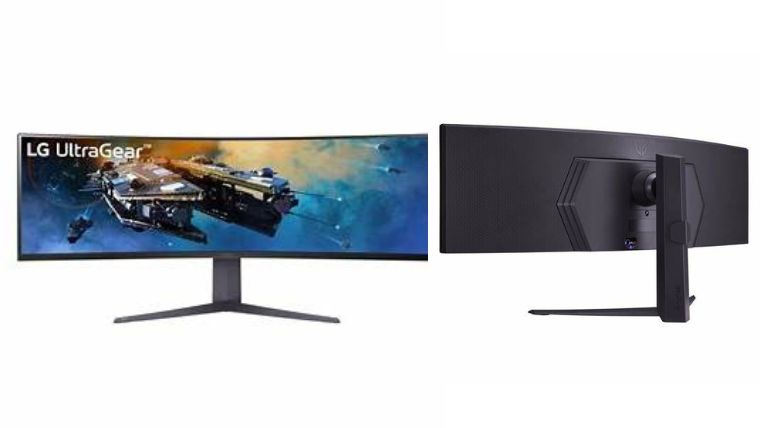
| Specifications | Details |
| Screen Size | 45 inches (curved, 1500R radius) |
| Aspect Ratio | 32:9 “Super Ultrawide” |
| Panel Type | VA (Vertical Alignment) panel |
| Response Time | 1ms GtG (VA panel) |
| Resolution | Dual-QHD 5120×1440 |
| Refresh Rate | 200Hz max (Adaptive-Sync, 48–200Hz VRR range) |
| Brightness | 400 nits SDR / 600 nits Peak (DisplayHDR 600) |
| Weight | 8.8 kg (19.4 lbs) |
I can confidently say that LG’s 45GR65DC-B beast is the ultimate curved gaming monitor for ultra-wide aficionados. At 45 inches diagonal with a 32:9 aspect ratio, it’s equivalent to two 27” 1440p monitors fused. The result is utterly immersive. The 1500R curvature and sheer width fill your peripheral vision completely.
Any game that benefits from a wide-field view shines on this monitor. Games like flight sims, open-world games, and racing titles. Reddit users described it as “a total game-changer. Like going from a regular TV to a high-end cinema screen.” Based on extensive research and analysis, I wholeheartedly agree. Of course, immersion isn’t only about size. The monitor backs it up with serious performance.
It sports a high-contrast VA panel that delivers deep, inky blacks and a 3000:1 contrast ratio. Dark scenes in games look terrific; exploring caves or space in Star Citizen, the monitor’s near-OLED-level blacks make the experience incredibly atmospheric. Yet unlike most VA monitors, this one is fast. LG pushed it to a 200Hz refresh with a claimed 1ms response.
In practice, motion handling is excellent: fast-paced shooters and action games run smoothly with minimal blur or ghosting. Even in tricky dark transitions, the panel performed well; only a faint bit of VA pixel persistence (“black smear”) is present if you look for it on very dark backgrounds. Input lag is low and it supports FreeSync Premium Pro (and G-SYNC Compatible).
The gameplay feels snappy and tear-free at all times. Pushing 5120×1440 at 200 fps demands a beefy GPU. However, there’s no tearing or judder and just fluid motion across a mega screen thanks to VRR. Feature-wise, this curved gaming monitor features Picture-by-Picture and Picture-in-Picture. You can display two inputs at once (now you’ve got 2 screens in 1).
It’s great overall but you need desk space and a powerful PC to fully appreciate it.
| Pros | Cons |
|---|---|
| ✅ Incredibly immersive 32:9 curved screen | ❌ Not all games support ultrawide without tweaks |
| ✅ Massive “dual QHD” resolution (5120×1440) | |
| ✅ 200Hz refresh + 1ms response | |
| ✅ Excellent contrast and HDR600 | |
| ✅ Adaptive-Sync + Low Input Lag = tear-free, responsive gameplay even at this huge size |
Final Verdict: The LG 45GR65DC-B UltraGear 45”Massive 45” has a curved VA panel with 32:9 ultrawide aspect ratio which also makes it the best ultrawide gaming monitor in this price range. It allows dual input use. Another option would be the AOC Agon PRO AG346UCD offers a 34-inch ultrawide gaming experience at a lower price.
Get LG 45GR65DC-B UltraGear 45 on Amazon >
4. Sony 27” INZONE M9 Gaming Monitor [Best 4K Monitor]
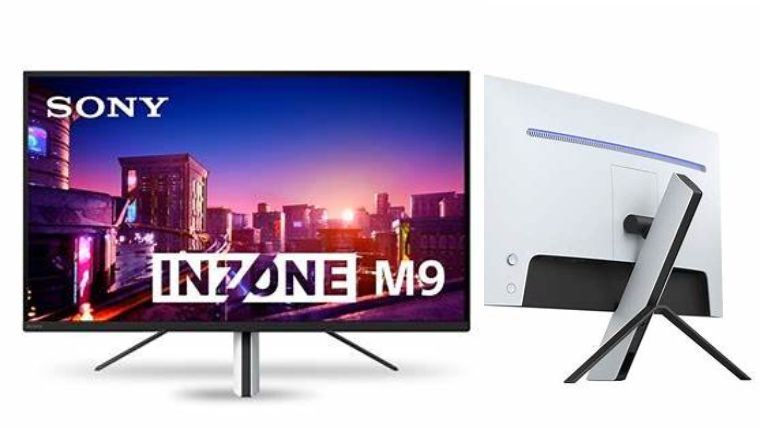
| Specifications | Details |
| Screen Size | 27 inches (IPS, Full-Array Local Dimming – 96 zones) |
| Aspect Ratio | 16:9 |
| Panel Type | IPS LCD panel |
| Response Time | 1ms GtG (Fast IPS) |
| Resolution | 3840 x 2160 (4K UHD) |
| Refresh Rate | 144Hz (120Hz PS5/XSX via HDMI 2.1) |
| Brightness | ~600 nits Peak (DisplayHDR 600 certified) |
| Weight | 6.8 kg (14.99 lbs) |
“Is it worth it?” That was my big question going into the Sony INZONE M9, given its higher price tag for a 27-inch monitor. The answer is a resounding yes. This monitor delivers an experience that justifies being crowned the best 4K gaming monitor in its class. The star of the show is the full-array local dimming (FALD) backlight. It can brighten and dim dynamically.
This feature gives HDR content a real punch: For example, Cyberpunk 2077’s neon signs glow intensely against truly dark city streets, something standard edge-lit IPS monitors just can’t do. One reviewer noted the M9’s HDR offers “an improved HDR experience” over other 4K IPS panels.
In normal gameplay and movies, the local dimming works wonders. It elevates contrast to an impressive degree. You’ll be struck by how much richer the image will look, almost like a pseudo HDR (but with better depth in shadows). This capability sets the INZONE M9 apart from competitors like the LG 27GP950 or Gigabyte M28U.
The INZONE M9 features a Fast IPS 4K panel that runs up to 144Hz. It’s razor-sharp and buttery-smooth. At 27 inches, 4K resolution yields a 163 PPI pixel density. Games and text look extremely crisp. Speaking of games, this monitor is made for the PS5. Sony equipped it with two HDMI 2.1 ports, so it handles 4K 120Hz from the PS5 and Xbox Series X easily.
Plus, it supports the PS5’s Auto HDR Tone Mapping. When you connect a PS5, the console automatically recognizes the M9 and optimizes HDR output for it.
| Pros | Cons |
|---|---|
| ✅ Exceptional 4K HDR picture for the size | ❌ Limited stand adjustment: tilt and height only, no swivel or pivot |
| ✅ HDMI 2.1 ports for 4K 120Hz, Auto HDR Tone | |
| ✅ Mapping and genre picture modes for PS5 | |
| ✅ 144Hz + 1ms IPS for smooth motion and low input lag | |
| ✅ G-SYNC Compatible and FreeSync Premium | |
| ✅ Integrated KVM USB hub simplifies using one keyboard/mouse |
Final Verdict: The Sony 27” INZONE M9 is PS5-optimized with Auto HDR Tone Mapping and 4K 120Hz HDMI 2.1 support. It is considered as the best monitor for PS5 based on its specs, features and performance. A good alternative would be the Acer Predator XB283K offers 4K 144Hz and HDMI 2.1 support at a lower price.
Check Sony 27” INZONE M9 on Amazon >
5. AOC Agon PRO AG346UCD 34” Gaming Monitor [Best Ultrawide Monitor]
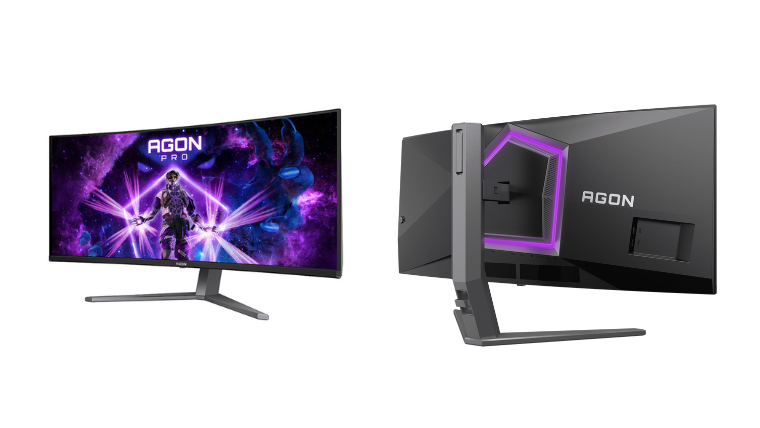
| Specifications | Details |
| Screen Size | 34 inches QD-OLED (1800R curve) |
| Aspect Ratio | 21:9 Ultrawide |
| Panel Type | QD-OLED panel |
| Response Time | 0.03ms GtG |
| Resolution | 3440×1440 |
| Refresh Rate | 175Hz (Adaptive Sync, LFC support) |
| Brightness | ~250 nits fullscreen (HDR True Black 400) |
| Weight | 7.65 kg (16.87 lbs) |
Gaming on the AOC Agon PRO AG346UCD is a joyful experience. It’s not a stretch to say it’s one of the most balanced ultrawide gaming monitors in the market right now. You get ultrawide immersion and insane image quality. You can thank the 34” curved screen and QD-OLED for that. The visuals are jaw-dropping.
The deep and infinite contrast makes every element on-screen illuminate dramatically. You won’t see any halo or blooming from bright lights or HUD elements against dark backgrounds. Each pixel shines independently. AOC’s implementation is using QD-OLED tech. It has quantum dot enhancement for color. In practical terms, this means that colors POP. Lush, saturated colors still retain their nuances. Overall, colors have depth and layers.
The 21:9 ultrawide format itself is a massive plus. You’ll experience true immersion with it. In supported games, the extended field of view is a real advantage. You can see more enemies in your periphery and the sense of scale in open-world games is quadrupled. The 3440×1440 resolution hits a sweet spot too.
It’s far less demanding than 4K, so reaching the 175Hz refresh is feasible with a decent GPU. Still, it remains looking plenty sharp at 34”. At the end of the day, the AOC Agon PRO AG346UCD is a top-tier ultrawide gaming monitor that lets you enjoy speed, performance, image quality, and immersion. You don’t need to compromise with this monitor because you get ALL of it. While it is an investment, it pays off.
| Pros | Cons |
|---|---|
| ✅ Stunning OLED visuals | ❌ Lacks HDMI 2.1 bandwidth. Consoles run at 1440p 120Hz, not 4K |
| ✅ Quantum Dot OLED panel = bright, pure colors and high peak brightness | |
| ✅ Virtually zero motion blur | |
| ✅ 175Hz ultrawide experience with Adaptive-Sync eliminating tearing at all frame rates | |
| ✅ Ultra-wide 21:9 aspect at 3440×1440 |
Final Verdict: The AOC Agon PRO AG346UCD 34” monitor provides breathtaking QD-OLED visuals and 175Hz refresh for smooth gameplay. If you want a cheaper option, the LG 45GR65DC-B offers a 45” VA panel and deep contrast for less money.
See the AOC Agon PRO AG346UCD 34” on Amazon >
6. ASUS TUF 27” Gaming Monitor [Best 1440p Monitor]
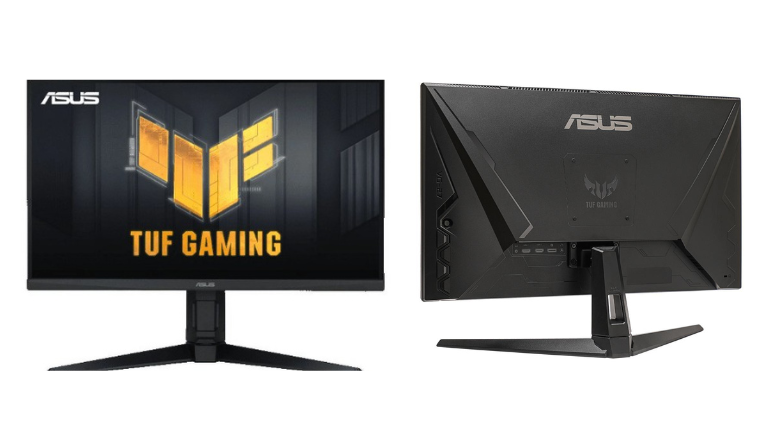
| Specifications | Details |
| Screen Size | 27 inches IPS (non-glare) |
| Aspect Ratio | 16:9 |
| Panel Type | IPS (In-Plane Switching) |
| Response Time | ~4ms GtG (1ms MPRT via backlight strobe) |
| Resolution | 2560 x 1440 (QHD 1440p) |
| Refresh Rate | 165Hz (OC 170Hz) w/ ELMB Sync |
| Brightness | ~350 nits SDR / HDR10 support (400-nit peak) |
| Weight | 5.8 kg (12.8 lbs) |
If you want an affordable 27-inch 1440p monitor that gives you silky-smooth motion and high refresh rates, then you’ve struck gold with the ASUS TUF Gaming VG27AQ. It consistently rises to the top of recommendations in this field. It’s because it gives you what you need for much less money. This affordable gaming monitor provides a big, sharp picture that’s easier on the GPU than 4K.
Plus, for what it delivers, its price truly makes buying it one of the best gaming monitor deals. The 2560×1440 resolution at 27 inches is the sweet spot. Everything looks appreciably sharper than 1080p without the need for insane hardware to drive it. You’ll be able to run games like The Witcher 3 at 1440p and push well over 100fps on a mid-to-high-tier graphics card.
From extensive research and analysis, buyers noted that switching to this monitor increased resolution and refresh rate substantially. For gamers who enjoy fast-paced games, this means the motion clarity will be great. It delivers on visuals and smoothness, that’s for sure. Moreover, the VG27AQ’s IPS panel impresses with vibrant colors and wide viewing angles.
But, where this TUF monitor truly delivers is motion handling. It’s a 165Hz panel that can be overclocked to ~170Hz, and the response times are very good, especially with ASUS’s overdrive set appropriately. Lastly, this ASUS TUF model has earned a reputation for amazing value and reliability. It often comes in much cheaper than other 1440p high-end monitors, but it delivers 95% of the experience.
| Pros | Cons |
|---|---|
| ✅ Excellent 1440p visuals | ❌ No USB-C or KVM. Connectivity is basic, focusing on core HDMI/DP ports |
| ✅ 165Hz refresh + low input lag | |
| ✅ Unique ELMB Sync tech allows simultaneous motion blur reduction and adaptive sync | |
| ✅ Adaptive-Sync works flawlessly | |
| ✅ Offers high-end features (165Hz, HDR, ELMB) at a mid-range price |
Final Verdict: The ASUS TUF VG27AQ gives you sharp visuals, fast refresh rates, and vibrant IPS colors. Another option would be the ASUS ROG Strix 27”. It delivers even better HDR for a more refined experience.
7. ASUS ROG Strix 27” Gaming Monitor [Best 27 Inch Monitor]
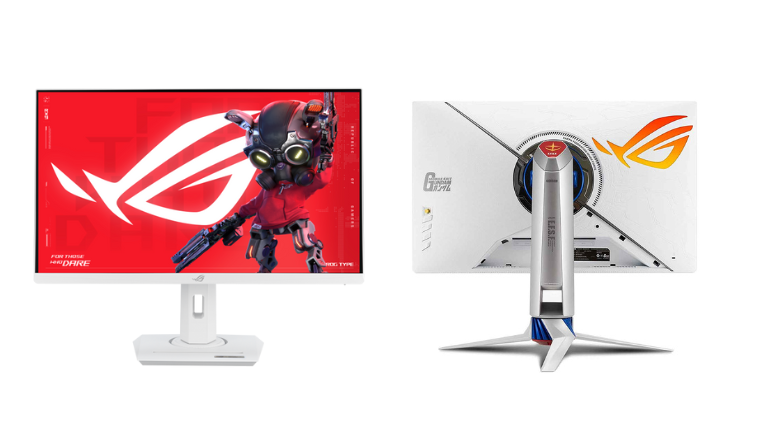
| Specifications | Details |
| Screen Size | 27 inches Fast IPS (Aura Sync lighting) |
| Aspect Ratio | 16:9 |
| Panel Type | IPS (In-Plane Switching) |
| Response Time | 0.5ms GtG (Fast IPS with overdrive) |
| Resolution | 2560 x 1440 (QHD) |
| Refresh Rate | 270Hz (OC) / 240Hz native – NVIDIA Reflex Latency Analyzer built-in |
| Brightness | 400 nits SDR / HDR400 (450+ nits peak) |
| Weight | 5.8 kg (12.8 lbs) |
Meet one of the fastest gaming monitors available for casuals and pros. The ASUS ROG Strix 27” XG27AQM is THE 27-inch gaming monitor to beat, especially if you’re in competitive gaming. It leverages the already-excellent foundation of 27” 1440 IPS with an incredible 270Hz refresh rate. This results in a display that FEELS and IS incredibly fast and fluid.
So, jumping into matches of Valorant and CS:GO, the difference between 144Hz and 270Hz is noticeable in the tiniest of ways. To a pro gamer, these small differences can cumulatively end in winning or losing. Input feels a hair more instant and tracking targets during flick shots is just that much easier. Especially when the frame rate can match your reactions. Motion clarity at high refresh rate is outstanding.
The Fast IPS panel ASUS uses here is one of the quickest ever tested. I’ve found its response times to be around 4ms or better, which is excellent for 240Hz+. Plus, with overdrive tuning the visual response rating is superb. In practice, ghosting is basically a non-issue at 270Hz.
But what impressed me the most is that ASUS managed to achieve this speed without messing up color and resolution! The monitor truly delivers beautiful visuals with rich colors (it’s nearly 97% DCI-P3 gamut).
Overall, the ASUS ROG Strix XG27AQM exemplifies overkill in the best way. It’s one of the top 27-inch gaming monitors for those who want no-holds-barred performance. It gives you high resolution, high refresh, and high responsiveness all in one.
| Pros | Cons |
|---|---|
| ✅ Blazing-fast 270Hz refresh, among the highest for 1440p | ❌ Needs a powerful GPU to fully exploit 240–270Hz at 1440p |
| ✅ Fast IPS with 0.5ms GtG, outstanding motion clarity with minimal ghosting | |
| ✅ Excellent color and accuracy for a high-refresh panel | |
| ✅ Supports ELMB Sync (backlight strobing + VRR) | |
| ✅ Premium ROG build: distinct Strix design, RGB backlighting and integrated latency analyzer for eSports tuning |
Final Verdict: The ASUS ROG Strix 27” XG27AQM is the ultimate 27-inch monitor for competitive players. As an alternative, the Sony INZONE M9 is another high-end 27” 4K gaming monitor with full-array local dimming for superior HDR performance.
See ASUS ROG Strix 27 on Amazon >
8. MSI MPG 321URX QD-OLED Gaming Monitor [Best 32 Inch Monitor]
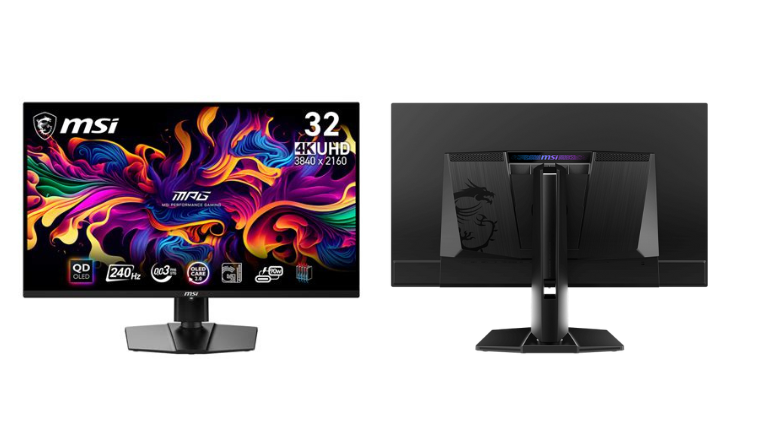
| Specifications | Details |
| Screen Size | 32 inches Rapid IPS (Quantum Dot enhancement) |
| Aspect Ratio | 16:9 |
| Panel Type | QD-OLED panel |
| Response Time | 1ms GtG (Fast IPS) |
| Resolution | 3840 x 2160 (4K UHD) |
| Refresh Rate | 144Hz (120Hz via HDMI 2.1 for consoles) |
| Brightness | 400 nits SDR / 600 nits Peak (VESA DisplayHDR 600) |
| Weight | 7.5 kg (16.5 lbs) |
Enter the great OLED widescreen monitor that could be the new part you need for your gaming setup. The MSI MPG 321UR-QD monitor boasts size, color, and accessibility for multiple devices/consoles. The monitor’s system was designed to balance an impressive gaming monitor screen size with clarity. The pixel density (~140 PPI) is higher than a 27” 1440p, so games and text look very sharp.
4K content really shines on this monitor and you’ll be blown away by the fine details visible on such a large screen. Moreover, this model is actually dubbed the “Xbox Edition” because MSI tailored it heavily for console compatibility: two HDMI 2.1 ports let you run your PS5 or Series X at full 4K 120Hz with VRR.
The IPS panel with Quantum Dot is one of the best I’ve seen in color performance. It’s extremely saturated (in a good way) and can cover wide gamuts. It’s full Adobe RGB and about 97% of DCI-P3. Color us impressed. Moving on to features, the monitor has a whopping 6 USB ports (3 upstream if you count the USB-B for KVM, and 3 downstream for devices).
It basically acts as a hub for everything. There are also gaming OSD features: crosshair overlays, a timer, a refresh rate counter, and even a “Night Vision” mode (MSI’s term for shadow boost to brighten dark areas). Many other 32” 4K monitors with similar specs cost more and have fewer features than the MSI MPG 321UR-QD. Overall, The MSI MPG 321UR-QD gives you value for your money.
| Pros | Cons |
|---|---|
| ✅ Gorgeous 4K image at 32″, large screen with high pixel density yields | ❌ OSD can be a bit complex due to the amount of features |
| ✅ Quantum Dot IPS panel produces tremendously rich color | |
| ✅ Fast 144Hz refresh & 1ms response | |
| ✅ Two HDMI 2.1 ports,designed for PS5/XSX at 4K 120Hz with VRR | |
| ✅ Low input lag and FreeSync Premium Pro |
Final Verdict: The MSI MPG 321UR-QD is a feature-packed 32-inch 4K gaming monitor ideal for multi-device gaming and workstation setups. A cheaper alternative? Acer Predator XB283K gives you 4K 144Hz, HDMI 2.1, plus excellent color accuracy for less money.
See MSI MPG 321URX QD-OLED on Amazon >
9. SAMSUNG 49″ Odyssey QD-OLED Gaming Monitor [Best 49 Inch Monitor]
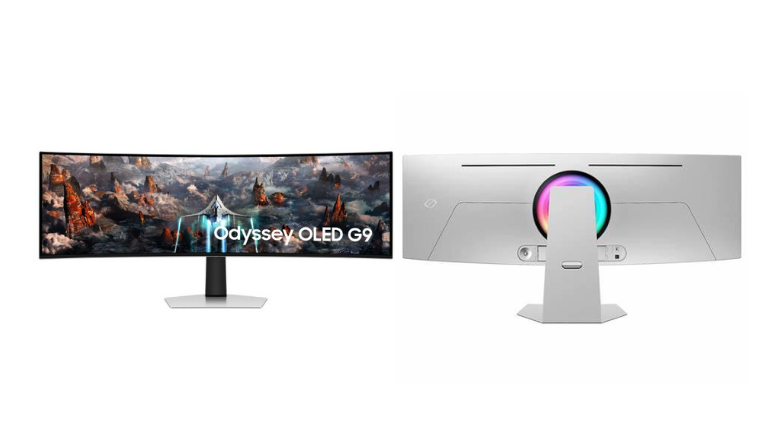
| Specifications | Details |
| Screen Size | 49 inches QD-OLED (1800R curve, ultra-wide 32:9) |
| Aspect Ratio | 32:9 |
| Panel Type | QD-OLED |
| Response Time | ~0.03ms GtG (OLED instantaneous pixel response) |
| Resolution | 5120 x 1440 (Dual-QHD) |
| Refresh Rate | 240Hz |
| Brightness | 250 nits fullscreen / ~1000 nits peak |
| Weight | 14.1 kg (31.1 lbs) |
The Samsung Odyssey OLED G9 is awe-inspiring especially when it comes to image display and immersive qualities. This gigantic 49-inch display is essentially two 27-inch 1440p monitors fused together. This gaming monitor has a gentle 1800 curve. When you’re sitting in front of it, it’s ALL you can see. It immerses you on a next level.
Playing a game like Cyberpunk 2077 or Flight Simulator 2020 on this monitor is a transformative experience. The world wraps around you and thanks to the OLED’s perfect blacks and rich colors. It feels almost like looking through a window into another reality. The Samsung Odyssey OLED G9 brings the cinematic visuals of OLED TVs into a monitor form factor and adds the high refresh that gamers need.
Gaming performance is top-tier as well. The panel runs at 240Hz, which for a 49″ 5120×1440 OLED is mind-blowing. At 240Hz, you can expect that motion is on another level of fluidity. Combining that refresh rate with OLED’s instant pixel response, and you get motion clarity that’s free of blur. Fast-moving targets in Call of Duty: Warzone are easier to track and the overall feel is just unbelievably smooth.
All considered, the Odyssey OLED G9 delivers an unparalleled gaming experience. It is absolutely one of the best super-ultrawide monitors you can get right now.
| Pros | Cons |
|---|---|
| ✅ Enveloping 49″ curved OLED screen | ❌ Needs significant space |
| ✅ Perfect blacks and infinite contrast | |
| ✅ Ultra-fast 240Hz refresh + near-zero pixel response | |
| ✅ Quantum Dot OLED color | |
| ✅ HDR10+ Gaming support for dynamic HDR tone mapping |
Final Verdict: The Samsung Odyssey OLED G9 is a 49-inch QD-OLED ultrawide monitor with perfect blacks, vivid colors, and a 240Hz refresh rate. An alternative choice is the AOC Agon PRO AG346UCD. It offers QD-OLED visuals and 175Hz refresh in a more compact 34-inch ultrawide format (and a lower price).
Check SAMSUNG 49″ Odyssey QD-OLED on Amazon >
10. LG UltraGear 32GS95UV 32” OLED Gaming Monitor [Best OLED Monitor]
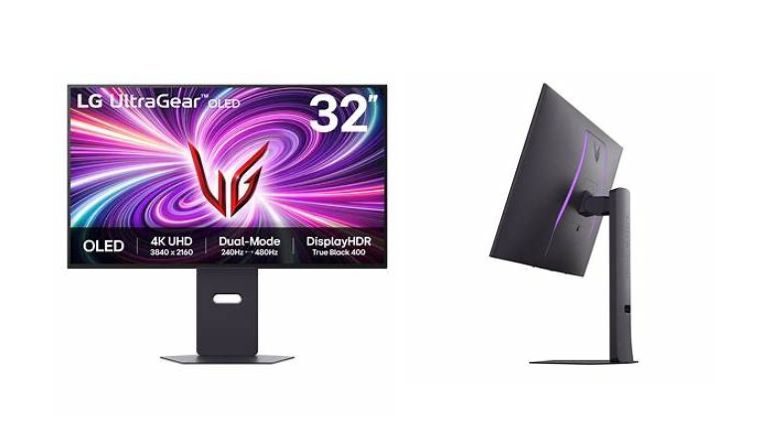
| Specifications | Details |
| Screen Size | 32 inches WOLED (flat panel, anti-glare coating) |
| Aspect Ratio | 16:9 |
| Panel Type | Nano IPS |
| Response Time | ~0.03ms (OLED instantaneous) |
| Resolution | 3840 x 2160 (4K UHD) |
| Refresh Rate | 240Hz (native) |
| Brightness | ~250 nits fullscreen / 800+ nits peak (DisplayHDR True Black 400) |
| Weight | 6.9 kg (15.2 lbs) |
The LG UltraGear 32GS95UV packs a serious punch. This monitor takes LG’s renowned OLED technology (as seen in their TVs) and optimizes it for desktop gaming in a way that simply hasn’t been done before. First, the visuals: As expected from OLED, the picture is sublime. Every pixel emits its own light, so blacks are completely black.
The contrast and color fidelity are breathtaking; the monitor covers 133% of sRGB and ~95% DCI-P3, so colors are rich yet accurate. Now, what really sets the 32GS95UV apart is the performance and the Dual-Mode feature. This monitor’s native operation is 4K at 240Hz: an already groundbreaking spec as it’s the first of its kind. Playing at 240Hz in 4K is a joy (if your system can push high frames).
Even at lower fps in more demanding games, the combination of VRR and OLED fast response makes everything feel smooth. But LG didn’t stop there: they added a 480Hz mode at 1080p for the hardcore competitive gamers! With a quick hotkey or OSD toggle, you can have the monitor drop to 1920×1080 and refresh up to 480Hz.
It even has options to shrink the display area to 27” or 24” size (with black bars) at that 1080p resolution, which effectively mimics sitting further from a smaller screen. The idea is to let your eyes take in the whole screen easily for eSports like CS:GO or Valorant.
In conclusion, the LG 32GS95UV is hands-down the best OLED gaming monitor right now because it combines the strength of OLED (contrast, color, speed) with innovations tailored to gamers (Dual-Mode 480Hz, etc.) that no other monitor offers.
| Pros | Cons |
|---|---|
| ✅ Breathtaking OLED picture | ❌ Expensive flagship (priced akin to high-end TVs) |
| ✅ Dual-Mode 480Hz, unique feature lets competitive gamers switch to 1080p at an insane 480Hz with options to mimic a 27″ or 24″ screen size for focused play | |
| ✅ 240Hz at 4K | |
| ✅ Near-instant response times (0.03ms) = zero motion blur or ghosting | |
| ✅ HDMI 2.1 and VRR fully supported |
Final Verdict: The LG UltraGear 32GS95UV is perfect for both immersive gaming and high-speed eSports because it’s a groundbreaking OLED gaming monitor with 4K 240Hz performance. Alternative choice? The MSI MPG 321UR-QD offers 4K 144Hz and HDMI 2.1 support, giving you excellent performance at a lower cost.
Get LG UltraGear 32GS95UV 32” OLED on Amazon >
11. KTC G27P6 27” OLED Gaming Monitor [Best Monitor With Speakers]
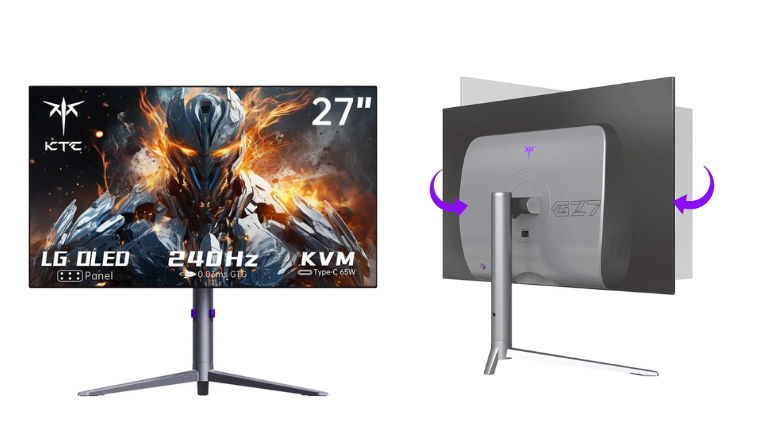
| Specifications | Details |
| Screen Size | 27 inches OLED (flat panel, low-reflection coating) |
| Aspect Ratio | 16:9 |
| Panel Type | Nano IPS |
| Response Time | ~0.03ms (virtually instant, no ghosting) |
| Resolution | 2560 x 1440 (QHD 1440p) |
| Refresh Rate | 240Hz |
| Brightness | ~250 nits peak (HDR10 supported – per-pixel contrast) |
| Weight | 6.9 kg (15.2 lbs) |
If you haven’t heard of KTC, you’re not alone. I was initially skeptical of this lesser-known brand. But their G27P6 OLED monitor has proven to be one of the best gaming investments out there, especially considering its price and features. Let’s start with the gaming experience: being a 27-inch OLED at 1440p 240Hz, it hits a sweet spot for competitive and immersive gaming alike.
The image quality is just gorgeous. This panel is made by LG (KTC sources it, much like Dell and others do), so you’re getting that OLED magic. Perfect blacks and essentially infinite contrast. When you load up a game like Elden Ring or Batman: Arkham Knight, nighttime scenes or dark dungeons are rendered with inky black shadows and no hint of the gray wash you see on IPS or even VA.
Gaming performance is stellar. The response time is essentially instantaneous, so the motion clarity is better than any 240Hz LCD I’ve seen. There’s no need for overdrive tuning or motion blur reduction; even in frantic shooters like Quake Champions or Apex Legends, moving objects stay crisp.
Built-in speakers on a monitor are usually an afterthought, but KTC bucked that trend. The G27P6 packs two 5W speakers, and they’re usable for gaming and media. The sound is “robust and smooth” as KTC advertises. The KTC G27P6 27” has the core benefits of OLED, and then it sweetens the deal with genuinely good integrated speakers and rich connectivity.
| Pros | Cons |
|---|---|
| ✅ Superb visual quality | ❌ Peak brightness is modest, not ideal for HDR highlights in very bright environments |
| ✅ High-speed 240Hz refresh at 1440p with near-zero pixel response | |
| ✅ Impressive built-in speakers, dual 5W speakers produce rich, immersive sound | |
| ✅ Excellent value, offers OLED performance at a price far lower than big brands | |
| ✅ Low input lag and flawless VRR |
Final Verdict: The KTC G27P6 is a 27″ OLED gaming monitor with smooth 240Hz performance and OLED’s incredible contrast, plus surprisingly good built-in 5W speakers that set it apart. Another choice is the LG UltraGear 32GS95UV. It offers 4K 240Hz performance, 1080p 480Hz Dual-Mode, and premium OLED quality.
See KTC G27P6 27” OLED on Amazon >
Key Specs and Features To Consider Before Buying the Best Monitor For Gaming
Several KEY specs impact your monitor’s performance, visual clarity, immersive potential, and overall gaming experience. Let’s break down a few critical points so you remember it when purchasing a new
1. Screen Size Matters: Finding the Right Monitor Size for Gaming
The right screen size for gaming depends on your setup and preferred gaming experience.
- 24–27 inches: Ideal for competitive gaming; keeps everything within your field of view.
- 32 inches: Great for immersive single-player and console gaming.
- 34 inches+ (Ultrawide): Best for simulation games and multitasking.
2. Understanding Refresh Rates: Why 144Hz and 240Hz Matter for Gamers
Refresh rate correlates directly to how smooth motion from games appears on-screen. Higher refresh rate equals smoother motion and better gameplay. Higher refresh rate means better responsiveness and less screen tearing.
- 60Hz: Basic standard, but not ideal for fast-paced gaming.
- 120Hz–144Hz: Great for most gamers; smoother animations, reduced motion blur.
- 240Hz+: Perfect for esports and FPS games.
3. Resolution Choices: Comparing 1080p, 1440p, and 4K Monitors
A higher resolution improves image clarity but it also demands more GPU power!
- 1080p (FHD): Best for budget gaming and high refresh rates.
- 1440p (QHD: A balance of performance and sharp visuals; ideal for most gamers.
- 4K (UHD): Offers rich detail but requires a powerful graphics card to be leveraged properly (and to run smoothly).
4. Panel Types Explained: IPS vs. TN vs. VA for Gaming
Panel types will affect your monitor’s color accuracy. It will also affect response times and viewing angles. For most gamers, IPS panels are ideal. They offer a balance of speed and visuals.
- IPS (In-Plane Switching): Best color accuracy and wide viewing angles which is great for RPGs and immersive gaming.
- TN (Twisted Nematic): Fastest response times but weaker colors. Ideal for competitive FPS gaming.
- VA (Vertical Alignment): Better contrast than IPS but slower response times might lead to ghosting.
5. OLED vs. Mini-LED vs. LCD: Which Display Technology Wins?
Display technologies affect and directly impact brightness, contrast, and color depth. OLED is usually the best for premium visuals. On the other hand, Mini-LED balances brightness and contrast without worrying about burn-in.
- OLED: Perfect blacks, near-instant response time, but expensive with burn-in risks.
- Mini-LED: Brighter than OLED, improved contrast, but not true per-pixel lighting.
- LCD (LED-backlit): Most affordable but lacks the deep blacks and contrast of OLED and Mini-LED.
6. The Importance of Response Time in Gaming
A monitor’s response time affects how quickly pixels change color, in turn, this impacts motion clarity. For competitive gaming, 1ms or lower response time is ideal.
- 1ms GtG: Ideal for fast-paced FPS and esports; eliminates motion blur.
- 4-5ms GtG: Still acceptable for most gamers, but may show minor ghosting.
- 8ms+: Not recommended for gaming, as noticeable motion blur can occur.
7. The Role of Bit Depth and Color Accuracy in Gaming Monitors
Bit depth and color accuracy both impact visual realism. 8-bit or higher color depth usually produces more vivid and lifelike visuals.
- 6-bit + FRC (Frame Rate Control): Basic color depth, but not true 8-bit quality.
- 8-bit native: Standard for most gaming monitors, offering 16.7 million colors.
- 10-bit: Best for HDR gaming and content creation, displaying over 1 billion colors.
8. HDR in Gaming Monitors: Is It Worth the Investment?
HDR is a worthy investment if you want a monitor to deliver peak visuals in terms of brightness, color depth, and contrast. For true HDR gaming, DisplayHDR 600 and higher is the best thing to look out for.
- HDR10: Entry-level HDR, better contrast than SDR, but limited true effect.
- DisplayHDR 600+: Significant brightness and depth improvements.
- HDR1000 / True Black: The best HDR quality, found in premium OLED and Mini-LED monitors.
9. Dual Monitor vs. Ultrawide vs. Curved Monitor: Which is the Best for Gamers?
The best setup ultimately depends on you and your gaming style.
- Dual Monitor: Great for multitasking but has bezels between screens.
- Ultrawide (21:9 or 32:9): Seamless experience for racing, flight sims, and RPGs.
- Curved Monitors: Enhance immersion and reduce eye strain.
FAQs
What should I look for in a gaming monitor?
You should look at a gaming monitor’s refresh rate, response time, resolution, and panel type. A high refresh rate from 144Hz (or higher) improves gameplay smoothness, and so does a low response time (1-5ms). Certain panels like OLED, IPS, or QD-OLED deliver enhanced visuals and rich color accuracy.
What is the best panel type for gaming?
The best panel type for gaming depends on your needs. Competitive gamers opt for higher refresh rates and response time, while hobby gamers usually opt for enhanced visuals.
What is a good refresh rate for gaming?
Good refresh rates start from 144Hz or higher for gaming. Higher refresh rates reduce motion blur and makes gameplay smoother.
What is a good response time for a gaming monitor?
A good response time for a gaming monitor is 1ms to 5ms, as lower response times reduce ghosting and motion blur. OLED and QD-OLED panels have near-instantaneous response times. IPS and TN panels typically offer 1ms to 3ms response times.
What size monitor is best for gaming?
24-27 inches is great for competitive gaming, while 32-inch and ultrawide monitors enhance immersion for story-driven and open-world games.
Do gaming monitors have speakers?
Yes, some gaming monitors do come with built-in speakers – but don’t expect booming sound or deep bass. They’re usually there for convenience, like if you don’t want to mess with headphones or external speakers for a quick session.
Are gaming monitors good for work?
Yes, gaming monitors can be great for work, not just play. Most come with high refresh rates and fast response times, which isn’t just good for gaming but also makes everything feel super smooth, even when you’re just scrolling through spreadsheets.
Is a monitor better than a TV for gaming?
Yes, a gaming monitor is better than a TV for gaming if you prioritize faster response times, higher refresh rates, and lower input lag.
Who makes the best gaming monitors?
ASUS, LG, Samsung, Acer, MSI, and AOC, are known to make monitors with high refresh rates, low input lag, and premium panel technology. OLED and QD-OLED models from LG, MSI, and Samsung are currently the best for high-end gaming.
What monitors do pro gamers use?
Pro gamers typically use high-refresh-rate monitors, from 240Hz to 360Hz. They usually opt for monitors with low input lag and fast response times.
















